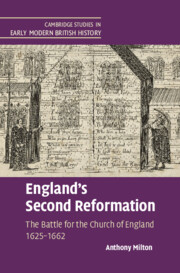Book contents
- England’s Second Reformation
- Cambridge Studies in Early Modern British History
- England’s Second Reformation
- Copyright page
- Dedication
- Contents
- Acknowledgements
- Abbreviations
- Introduction
- Chapter 1 An Unresolved Reformation
- Chapter 2 Situating the Laudian Reformation
- Chapter 3 Responses to the Laudian Reformation
- Chapter 4 The Abortive Reformation, 1640–1642
- Chapter 5 The End of Episcopalian Reformation
- Chapter 6 Reformation by Negotiation
- Chapter 7 The Westminster Reformation and the Parliamentarian Church of England
- Chapter 8 The Royalist Church of England, 1642–1649
- Chapter 9 Alternative Reformations, 1649–1653
- Chapter 10 The Cromwellian Church
- Chapter 11 Episcopalian Royalism in the 1650s
- Chapter 12 Failed Reformations, 1659–1661
- Chapter 13 The End of Comprehensive Reformation and the Caroline Settlement
- Conclusion
- Index
Conclusion
England’s Second Reformation
Published online by Cambridge University Press: 05 October 2021
- England’s Second Reformation
- Cambridge Studies in Early Modern British History
- England’s Second Reformation
- Copyright page
- Dedication
- Contents
- Acknowledgements
- Abbreviations
- Introduction
- Chapter 1 An Unresolved Reformation
- Chapter 2 Situating the Laudian Reformation
- Chapter 3 Responses to the Laudian Reformation
- Chapter 4 The Abortive Reformation, 1640–1642
- Chapter 5 The End of Episcopalian Reformation
- Chapter 6 Reformation by Negotiation
- Chapter 7 The Westminster Reformation and the Parliamentarian Church of England
- Chapter 8 The Royalist Church of England, 1642–1649
- Chapter 9 Alternative Reformations, 1649–1653
- Chapter 10 The Cromwellian Church
- Chapter 11 Episcopalian Royalism in the 1650s
- Chapter 12 Failed Reformations, 1659–1661
- Chapter 13 The End of Comprehensive Reformation and the Caroline Settlement
- Conclusion
- Index
Summary
The conclusion reviews the findings of the book, noting that the ‘second Reformation’ included a series of changes and reform endeavours – Laudian, abortive, Westminster, Cromwellian, Caroline – which all in their different ways sought to push the Church of England’s ambiguous Tudor legacy in specific new directions. It notes that all religious groups were prepared to contemplate change to the church’s pre-war formularies, and that all were indeed required to adapt their religious ideas and practices in the face of the upheavals of these years. Portraying the disruptions of the 1640s as the climax of the Church of England’s early history rather than as an aberration in an otherwise continuous ‘Anglican’ master-narrative, the book has demonstrated how many elements of the reforms of the 1640s and 1650s had been anticipated in the doctrines, practices, statutes, bills, and reform proposals of earlier decades. It also maintains that compromise and negotiation were as ubiquitous as change and radicalization in the period’s religious politics, and argues the need to look beyond the simple binary oppositions of contemporary polemic. The period is best seen as a time when everyone was obliged to rethink what the established church was and how its past should be understood.
- Type
- Chapter
- Information
- England's Second ReformationThe Battle for the Church of England 1625–1662, pp. 507 - 513Publisher: Cambridge University PressPrint publication year: 2021

